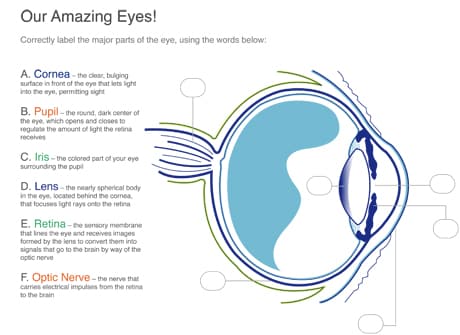Hey All!
Have you had your child’s vision checked yet this year? Well if you’re Latino like I am and if your family has a history of Diabetes then you should definitely be on top of keeping your children’s eyes healthy. Transitions Optical Healthy Sight Institute has reports that showed diabetes as the number one cause of all recent agents of blindness in the United States among patients 24 to 74 years of age. Also according to Transitions Optical, one in four children may have an undiagnosed vision problem that can interfere with the ability to read and learn. That’s a rather alarming rate and with kids diets these days, it’s not surprising. I’ve always worn glasses for reading since I was a kid. Luckily I don’t have any diabetes in my family that I know of and my teen doesn’t wear glasses. I guess I just got lucky my glasses wearing gene skipped him, but that doesn’t stop me from getting his eyes checked every year!
Transitions Optical would like to help you and your child learn how to keep your children’s eyes Healthy as they have partnered with the American Diabetes Association to launch “Eye Didn’t Know That” an interactive online site to help educate children, parents and even teachers about eye health. The site is fantastic and your kids will love it as it’s very interactive and it also has games and quizzes to help you and your child learn about the importance of maintaining healthy vision. You can also make the “My Eye Promise” which is of course making a promise with your child to keep your child’s eyes healthy. I made that promise and I feel you should too as we all want to keep our kids and family healthy in every way and that includes your vision! Being able to see is probably one of the most important things a person could have, so why not value this for your kids and make your kids value it as well.
I know medical bills can be rough but to help parents keep their kids eyes healthy, Transitions Optical, Inc announced its partnership with the American Diabetes Association (ADA) to educate and motivate consumers nationwide, particularly in ethnics groups such as Hispanics, African American and Asian American, to visit an eye doctor regularly for comprehensive eye exams, helping with the early detection of vision conditions, such as diabetic retinopathy.
Transitions Optical will offer free vision screenings during the ADA Expo in Chicago on Saturday, April 14, from 10 a.m. to 4 p.m. in booth #1221 at McCormick Place Chicago.
This is the second of three educational efforts, that began in L.A. last month, about proper eyecare and eyewear in which Transitions Optical will be participating to support the ADA.
ADA CITY SCHEDULE:
Chicago, IL
April 14, 2012
New York City, NY
November 3, 2012
For more info or to find a free vision screening near you, please visit www.EyeDidntKnowThat.info or you can also find the site in Spanish as well at: http://www.yonosabiaeso.com!

For more information about the company and the Transitions family of adaptive eyewear, visit http://www.transitions.com!
And for my Spanish speaking readers here is the above info in espanol por ti! Entre todos los factores que causan ceguera en los Estados Unidos, la diabetes es la causa principal en el grupo de personas de 24 a 74 años de edad, de acuerdo con el Instituto de Salud Visual de Transitions Optical. Por lo general, este desorden metabólico es diagnosticado por el proveedor primario de la salud, como el médico internista, el pediatra o el endocrinólogo. Sin embargo, un profesional de la salud visual también puede detectar las señales oculares relacionadas a esta condición.
El ojo es uno de los órganos más afectados por la diabetes, por lo tanto, los pacientes diabéticos pueden llegar a desarrollar ciertas condiciones visuales. La educación en torno a la importancia del cuidado apropiado de los ojos puede ayudar a prevenir las complicaciones que atentan contra la precisión visual. Los pacientes diabéticos deben someterse a exámenes regulares de la vista y utilizar protección ocular adecuada.
“Como en todas las ramas de la medicina, la detección temprana es la clave para prevenir las complicaciones diabéticas en el ojo”, explica Madeline L. Romeu, O.D., F.A.A.O. “Los pacientes diabéticos tienen mayor riesgo de desarrollar enfermedades que ocasionan ceguera, tales como la retinopatía diabética, cataratas, degeneración macular y glaucoma. Incluso, estudios demuestran que un 23.5 por ciento de los pacientes diabéticos de 50 años o más sufrirán de ceguera”.
Con el propósito de ayudar a prevenir las complicaciones visuales, se está llevando a cabo un proceso de identificación de los factores que pudiesen provocar el desarrollo de la diabetes. Dos de estos factores son la raza y la etnia. La incidencia de diabetes es más alta en algunos grupos de los Estados Unidos, incluyendo a los latinos.
“En el caso de los latinos, se estima que existen 2.5 millones de adultos, de 20 años de edad o más, que sufren de diabetes”, dijo Dr. Romeu. “Este grupo está 1.7 veces más propenso a desarrollar diabetes que las personas blancas que no son latinos”.
En adición a los factores hereditarios, existe un número de factores ambientales que pudiesen conducir al desarrollo de condiciones visuales. La causa número uno es la exposición a la radiación ultravioleta (UV), asociada comúnmente con el daño a la retina. La radiación UV también puede afectar la calidad y comodidad visual, ya que el resplandor puede llegar a ocasionar estrabismo y fatiga ocular.
Para más información sobre la salud visual y la diabetes, visite www.transitions.com.
****Disclosure: This is part of a sponsored campaign with Latina Mom Bloggers and Transitions Optical. However, all opinions expressed are my own.****















































Comments